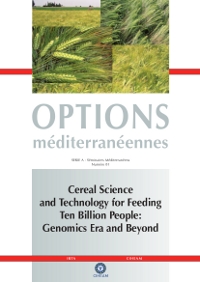| Article précédent | p. 373-376 | Article suivant |
Genetic improvement of Canadian durum wheat for sustainable production systems
Durum wheat (Triticum turgidum L. var durum) breeding began in Canada in the early 1950s with emphasis on improvement of yield, end-use quality and sustainable production through use of genetic resistance to insects and diseases. Genetic grain yield potential has increased by about 1% per year since release of the first cultivar in 1963. This was achieved within tightly-controlled end-use quality specifications for traits such as protein concentration, which was maintained at the level of the standard check cultivar Herucles. Gluten strength was increased in the 1960s to improve market opportunities and has recently been increased further, providing 'conventional' durum cultivars with gluten index of 50 to 70%, and 'strong gluten' cultivars with gluten index greater than 90%. Both semolina and pasta yellowness have been increased in recent cultivars, and cadmium concentration has been reduced by approximately 50%. There is genetic potential for further yield increases.
- [ Afficher ]
- [ Télécharger ]
- [ Exporter la citation ]
Vous pouvez télécharger la citation au format :
- [ Imprimer ]
-
Mots-clés
AUGMENTATION DE RENDEMENT, BLE DUR, CADMIUM, CEREALE, GLUTEN, RESISTANCE AUX FACTEURS NUISIBLES, VARIETECiter cet article
Clarke J.M. Genetic improvement of Canadian durum wheat for sustainable production systems. In : Molina-Cano J.L. (ed.), Christou P. (ed.), Graner A. (ed.), Hammer K. (ed.), Jouve N. (ed.), Keller B. (ed.), Lasa J.M. (ed.), Powell W. (ed.), Royo C. (ed.), Shewry P. (ed.), Stanca A.M. (ed.). Cereal science and technology for feeding ten billion people: genomics era and beyond. Zaragoza : CIHEAM / IRTA, 2008. p. 373-376. (Options Méditerranéennes : Série A. Séminaires Méditerranéens; n. 81). Meeting of the Eucarpia Cereal Section, 2006/11/13-17, Lleida (Spain). http://om.ciheam.org/om/pdf/a81/00800882.pdf



